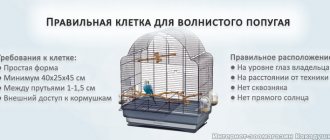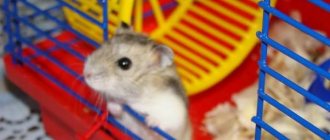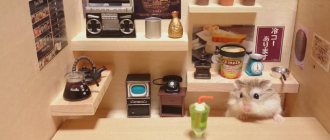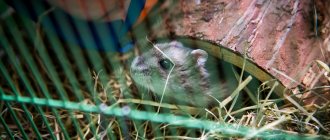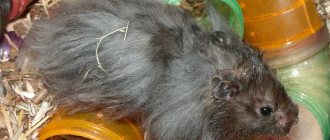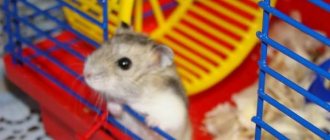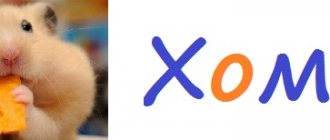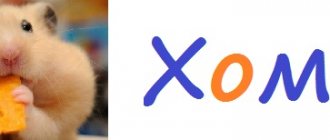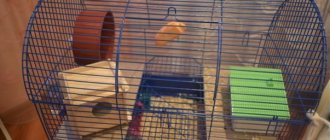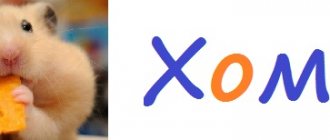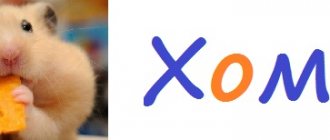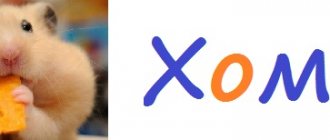Toilet
You can buy a toilet for your hamster at the pet store. The kit includes special granules that serve as bedding. They perfectly absorb all moisture, and therefore odor. Change once a week. Allows you to ensure cleanliness and freshness in the cage and room. In addition, they help clean the cage. It’s easier to just replace the litter in the toilet than to search throughout the cage where he did his job. But there is a nuance here: it is unlikely that an adult will be toilet trained, so this must be done as early as possible.
Pros and cons of content
Pros of keeping a hamster
- low cost of a hamster;
- low cost of accessories for maintenance;
- takes up little space;
- does not require special care and knowledge;
- does not make noise;
- no wool;
- no need for daily walks;
- you can keep one hamster, without a pair;
- does not pose a danger to both adults and children;
- easy to breed;
- easy to place the babies.
Disadvantages of keeping a hamster
- they sleep during the day and are active at night;
- unpleasant odor if you do not clean up food debris and excrement daily;
- low life expectancy, from 2 to 3 years;
- some individuals hibernate, depending on the species and conditions of detention.
House
What a hamster needs in a cage for sure is a house. As a rule, it is attached to the bars of the cage somewhere in the corner. The dimensions must be sufficient to accommodate all the supplies of the rodent and himself. The fact is that in the course of his life, he will drag all his food there, making a kind of warehouse. The inside should be darker than other areas of the cage, since it also serves as a shelter where the pet will experience unfavorable times. For example, after moving, he will be stressed and the pet will look for somewhere to hide, and in a dark place he will feel safe. Another use for it is for sleeping, but often the hamster does not sleep in the house and looks for another place for this. Don't worry about what you put in your hamster's house, he will find everything himself. But if you want to do everything in your power, buy a special filler for the house.
Fun outside the cage
The hamster's natural instincts are manifested in its behavior. Owners who want to diversify their rodent's stay in the house can pay attention to carriers. They are performed in the form:
- a walking ball - the animal will happily run around the apartment in such a device;
- plastic container - suitable for transporting a pet to a veterinary center, or for simple walks.
Attention! It is forbidden to carry a hamster in a pocket or bag. Indiscretion will result in loss, injury, and death of the baby.
Running wheel
The list of things a hamster needs in a cage must include a running wheel. It will allow the fluffy to always stay in shape. In the wild, they run many kilometers every day; this need must be satisfied at home. Otherwise, the animal will be lethargic and weak, it will have nowhere to put its energy, of which it has plenty. The wheel must meet certain standards. The dimensions must be correct, otherwise the hamster will not run in the wheel. For dzungaria, a diameter of 12 centimeters is suitable. Syrians need 18+. The running surface should not be slippery or contain holes where the foot could fall through. To keep your hamster cage healthy and active, your hamster cage accessories must include a running wheel.
List of required items
The hamster is an unpretentious animal, but this does not mean that it is not worth purchasing anything for a comfortable stay. There are a number of things that are vital. In their absence, it will be extremely difficult to make a nimble friend; his health depends on special things for the hamster. The following purchases are required:
- Cell;
- Feeder;
- Drinking bowl;
- House;
- Wheel.
To diversify everyday life, there are a number of things that brighten up your leisure time.
- Walking ball;
- Ladder;
- Pipes;
- Swing;
- Decorative feeder.
Buy a special balanced food for hamsters, filler, which includes sawdust, vitamins, and mineral stones.
Pet hamster diet
If you still decide to get a pet, you need to know what a hamster eats several times a day. Since this animal is active at night, select the most high-calorie foods for its evening meal. To avoid poisoning, do not feed him excessively watery food (watermelon, melon, cucumber, etc.).
Approximately once a day you need to give your pet a special food made from a mixture of grains, the range of which is offered by specialized pet stores for animals.
The hamster usually determines the norm for one meal without anyone's help, but food must be constantly present, as well as the presence of fresh water. Don't forget to make sure your pet drinks enough throughout the day, this is a vital condition for hamsters!
Approximate diet for a domestic hamster:
- Vegetables and fruits, pitted.
- Potato.
- Grain mixture.
- Lean cooked meat.
- Seeds and nuts in small portions.
- Vitamin complex.
It is highly undesirable to feed your animal garlic and onions, citrus fruits and tropical foods.
Home improvement
For normal activities, the animal is provided with a spacious and comfortable home. It is allowed to use a plastic house, a traditional cage or a large aquarium.
It is forbidden to place the hamster in a glass jar or small cardboard package.
The house should have enough space for:
- Small storage room.
- Toilet.
- Feeders and drinkers.
- Areas for activity.
- Bedrooms.
The pet will choose how to distribute its housing into zones. Therefore, it is better to give him free rein rather than try to accustom him to the designated places.
The house should be placed in a secluded place, protected from direct sunlight and street noise.
Cage selection criteria
There are several parameters that are taken into account when choosing a suitable home for a pet:
- Dimensions. They are determined taking into account the size of the pet. Small individuals lead an active lifestyle and need a supply of free space for play. The optimal dimensions of a hamster cage are 60 cm in length and 40 cm in width. The height of the structure does not play a special role.
- Material of manufacture. It is not advisable to use wooden cages for keeping rodents, since the animals will constantly gnaw on them and run away. The best solution would be a plastic or metal enclosure.
- Bottom type. It is recommended to choose designs in which the bottom is made in the form of a solid tray with a pull-out system. This will make it easier to clean the surface from dirt.
- Roof. Like the bottom, it is available in a removable format. This option will allow you to quickly remove the animal from the enclosure.
Sawdust
The optimal filler material for the cage is sawdust in granular form. You can also use corn raw material, hay and even plain paper, provided that it does not contain flavorings.
One of the unsuitable fillers is cotton wool. It is dangerous for miniature breeds, which can become entangled in the fibers.
Sawdust for filling the cage.
Drinker and feeder
As a drinking bowl for a hamster, you can use a simple bowl into which water is poured. The advantage of this option is its availability.
However, a rodent can easily turn the container over, being left without nutritious moisture on a hot summer day. In addition, particles of food or filler get inside the bowl, which negatively affects the quality of the liquid.
Automatic nipple drinkers are a more progressive solution. They are made in the form of a plastic cylinder with a steel nipple and two balls. A working system involves the release of water when you press the valve.
A feeder for the grain mixture is an optional attribute for the animal itself. It is more needed for the convenience of caring for the cage and maintaining cleanliness. However, the container in which vegetables, herbs, fruits and liquid food will be stored is irreplaceable.
When choosing a feeder, you should take into account that your pet can turn it over. Therefore, it is better to purchase a product with a heavy bottom made of ceramic or metal. In addition, you can install a hanging version in the cage, similar to bird models.
Drinking bowl for a hamster.
Toys and attractions
Hamsters are active pets that lead an active lifestyle. Therefore, in the enclosure it is necessary to provide a running wheel, a ladder and a slide where the rodent will spend its daily reserve of energy. Some owners buy a walking ball that will allow the animal to walk around the apartment.
If desired, you can design a park by installing labyrinths and obstacles from scrap materials. Paper towel and toilet paper tubes, cardboard and plastic bottles are suitable for this task.
Hamster wheel.
Keeping the house clean
To prevent the appearance of an unpleasant odor in the cage, it is important to keep the bedding, feeders and other accessories clean. Every day it is necessary to get rid of leftover food items that are subject to spoilage.
If you leave rotting fruit or stale meat in the house, this will lead to the development of dangerous microorganisms.
Room temperature
In the room where the hamster's cage is located, you need to maintain a temperature of 20°C. If you allow the indicators to deviate downwards, this will provoke hypothermia and the subsequent death of the animal. But you can’t install an enclosure near heating appliances either.
It is better to place the house in the back of the room and protect it from drafts. If the cage is on a windowsill, then it should be moved to another place for the ventilation period.
What types of hamsters are there?
Rodents vary in color, size and coat type. There are five types of domestic hamsters in total. Their standards, The National Hamster Council, are set by the National Association of Hamster Fanciers of England.
Syrian hamster
This is the largest Syrian Hamsters from home. The average length of its body is 13 cm. Females are sometimes larger than males.
The classic color of the Syrian hamster is golden brown. There is black ticking on the back - this means that areas of different colors alternate on the hairs. The animal's belly is white with gray undercoat, and there are dark spots on its cheeks.
Individuals of other colors are often found: white, cream, brown, black, gold, silver-gray, striped.
Hamsters of this species can have different coats. There are four types in total:
- Short . The soft fur fits snugly to the body.
- Long . The length of the hairs is from 7.5 to 10 cm.
- Rex . The fur appears tousled.
- Satin . The hair has a glossy shine. It is not recommended to crossbreed two hamsters with such hair, because sometimes the offspring will be bald.
Syrian hamster with classic color. Photo: Olena Kurashova / Shutterstock
Campbell's Russian Hamster
The body length of such a rodent, Dwarf Exhibition Standards, is 10–12 cm. There are three main colors of the animal:
- Normal . The hairs on the back are brown. The belly is white with gray undercoat. The eyes are black.
- Argenta . The top layer of wool is orange-sand, the bottom is smoky-gray. The eyes are red.
- Albino . These are completely white pets with bright pink eyes.
Hamsters with gray, beige, black and chocolate fur are considered non-standard.
Campbell's Russian hamster with normal color. Photo: softkrafts.live.com/Depositphotos
Djungarian hamster
This Dwarf Exhibition Standards animal is sometimes called the Russian white dwarf hamster. Its body length is 8–10 cm. All pets of this species have a black stripe on their backs. There are only three colors:
- Normal . The body is dark brown, with black ticking on a third of the hairs. The paws and belly are white, and the ears are gray.
- Pearl . The rodent's fur is white.
- Sapphire . The fur on the back is smoky gray with a blue tint, the belly is white.
Sapphire colored Djungarian hamster. Photo: Faifarris4746/Shutterstock
Chinese hamster
This rodent looks like a mouse without a long tail. Its body length is 10–12 cm, weight is 45–50 g. There are two main colors of the Chinese Hamster animal:
- Normal . The back and sides are brown with a chestnut tint, the belly is white. A black stripe stretches from the forehead to the tail.
- Spotted . Most of the fur is white. There is an elongated brown spot along the spine.
Albinos with black eyes are extremely rare. They come in litters from spotted parents. But this is the exception rather than the rule.
Chinese hamster with normal color. Photo: alexvey/Shutterstock
Roborovsky's hamster
The smallest of domestic rodents. It weighs only 20–25 g, and its body length is 4.5–5 cm. Typically, these animals have golden-brown fur on their face and back. The roots of the hairs are gray, and there are light spots near the eyebrows. But very rarely there are hamsters with a white muzzle.
Roborovsky's hamster. Photo: Anyarnia/Shutterstock
